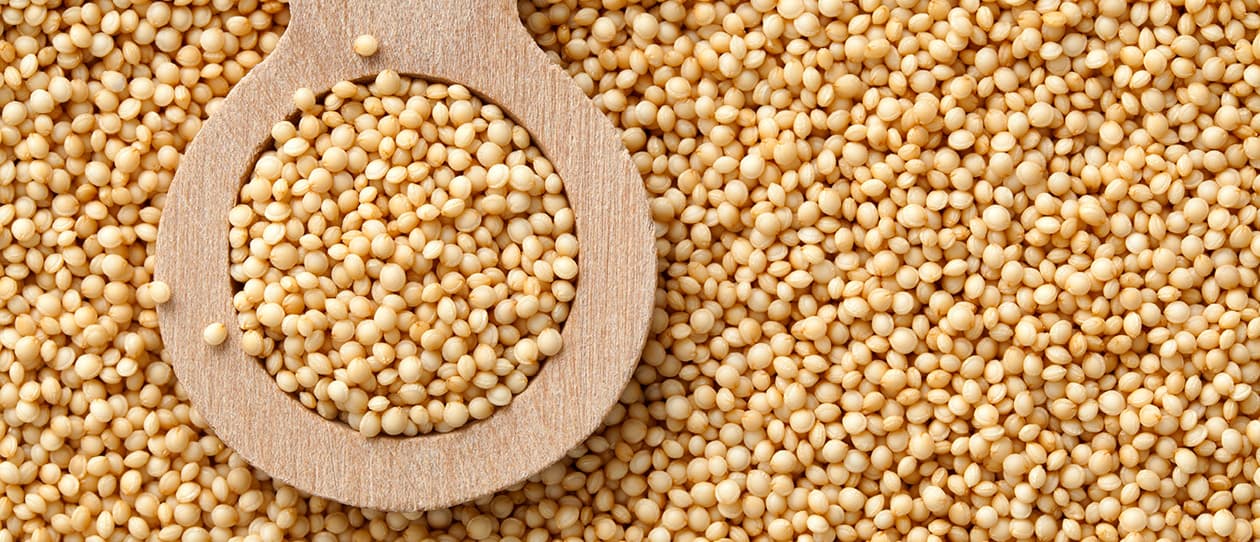
- Health hub/
- Tips & Advice on Improving your Everyday Health/
- Cooking Tips - Quinoa & Gluten Free Grains


Cutting out gluten from your diet doesn't mean you have to reduce your consumption of whole grains and cereals.
These foods provide essential minerals such as magnesium, iron and potassium, and vitamins such as the B group vitamins and vitamin E, as well as carbohydrates and fibre.
Whole grains make up an important part of a healthy diet.
Luckily, there are a variety of grains and cereals that do not contain gluten. Some of these include rice, corn, quinoa, millet and amaranth.
Cooking with quinoa
Quinoa (pronounced 'keen-wa' or 'kin-wa') is a grain native to the Andes of South America where it has been cultivated for over 6000 years. It provides a rich source of carbohydrates, essential fatty acids, vitamins, minerals and high quality protein.
It has a wonderful nutty flavour and a unique texture which makes it a wonderful addition to salads, soups, and curries, or as a substitute for rice.
Quinoa has a Glycemic Index (GI) value of 53, which makes it a low GI food. Low GI foods produce only small fluctuations in our blood glucose and insulin levels , important for general health and the prevention of several health conditions. Quinoa is known to contain higher amounts of iron and calcium than those found in corn or barley.
Cook quinoa in the same way as you would rice. One method is to boil two cups of water for every one cup of quinoa. Put a lid on, and let it simmer for 12 to 15 minutes or until the germ separates from the seed (the cooked germ looks like a tiny curl). Then remove from heat and let it stand for about 3 minutes to become fluffy.
Quinoa salad
Adding quinoa to your salad is a great way to boost its nutritional punch during the summer months. Try this tasty recipe to get your taste buds inspired.
- 1 cup cooked quinoa
- 1 handful of rocket
- 1 handful of baby English spinach
- 1 small clove of raw garlic finely diced
- Half a red capsicum, sliced
- One quarter of a spanish onion sliced
- One quarter of a cup of fetta cheese diced
- 2 tablespoons of flaxseed oil
- 3 tablespoons of tahini
- A splash of tamari
- A splash of apple cider vinegar
Combine ingredients in a bowl, and serve. (Hint: oven roasted vegetables added to this recipe make a tasty variation!)
Polenta
Polenta is simply corn meal, or ground corn. It can be cooked in a variety of ways, and it is popularly served as a mashed potato substitute, or baked, grilled or fried. Polenta has nutritional qualities of many other grains.
Polenta mash
Try this scrumptious recipe for a creamy polenta mash.
- 2 teaspoons of olive oil
- 1 small onion, finely chopped
- 1 clove of garlic, crushed
- 1 cup stock (vegetable or chicken)
- 3 cups organic milk or calcium enriched soy milk (or water)
- 1 cup polenta
- 3 tablespoons grated fresh parmesan cheese
- Cracked black pepper, to taste
Heat the oil in a fry pan and cook the onion over a high heat for about 1 minute. Remove from the stove and add the stock and milk. Bring the mixture to the boil and gradually add the polenta, stirring constantly.
Cook for about 10-15 mins stirring constantly until the polenta is thick and creamy, and no longer grainy.
Remove from the heat and stir in the parmesan cheese and pepper. Serve at once in recipes where you would usually use mashed potatoes.
Tomato, Mozzarella and Polenta Bake
Polenta can also be baked or fried to make a crispy cake, and it can be used in all manner of recipes.
One of these is this tasty recipe, but there is plenty of scope for imagination!
To bake, grill or fry polenta, follow the recipe above, then spread mix out evenly in a baking tin that has been brushed with a little oil. Set it aside to cool and harden, then cut it into desired shapes (squares, fingers, or triangles) and either grill, fry or bake until it browns.
Then, place polenta pieces on an oven tray and top with the following:
- slices of organic tomatoes
- fresh basil
- sliced mozzarella cheese
- fresh cracked pepper
- a pinch of iodised sea salt
Cook at 180°C until cheese melts. Remove it from the oven and drizzle with a touch of balsamic vinegar. Serve with your favourite salad greens.




